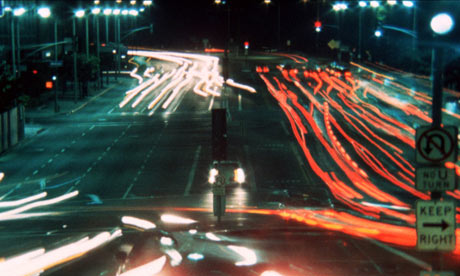It's a film without any characters, plot or narrative structure. And its title is notoriously hard to pronounce. What's not to love about Koyaanisqatsi?
I came to Godfrey Reggio's 1982 masterpiece very late. It was actually during a Google search a few years back when looking for timelapse footage of urban traffic (for work rather than pleasure!) that I came across a "cult film", as some online reviewers were calling it. This meant I first watched it as all its loyal fans say not to: on DVD, on a small screen. If ever a film was destined for watching in a cinema, this is it. But, even without the luxury of full immersion, I was still truly captivated by it and, without any exaggeration, I still think about it every day.
Koyaanisqatsi's formula is simple: combine the epic, remarkable cinematography of Ron Fricke with the swelling intensity and repeating motifs of Philip Glass's celebrated original score. There's your mood bomb, right there. But Reggio's directorial vision is key, too. He was the one who drove the project for six years on a small budget as he travelled with Fricke across the US in the mid-to-late 1970s, filming its natural and urban wonders with such originality.
Personally, I view the film as the quintessential environmental movie – a transformative meditation on the current imbalance between humans and the wider world that supports them (in the Hopi language, "Koyanaanis" means turmoil and "qatsi" means life). But Reggio has rightly refused to define the film's specific meaning; he even fought unsuccessfully with the distributor for the film to have no title. (Incidentally, it was only Francis Ford Coppola's last-minute support that helped push it into mainstream cinemas.)
"It's meant to offer an experience, rather than an idea," said Reggio in a 2002 interview (included with the DVD as a special feature). "For some people, it's an environmental film. For some, it's an ode to technology. For some people, it's a piece of shit. Or it moves people deeply. It depends on who you ask. It is the journey that is the objective."
It's the sort of answer you might expect from someone who was a resident member of the Christian Brothers teaching order from the age of 14 to 28. He also cites Luis Buñuel's Los Olvidados as one of his most moving spiritual experiences. But it was his time spent making shorts for the Institute for Regional Education in the early 70s that sparked Koyaanisqatsi. The New Mexico-based institute provided $40,000 of funding after he made them a series of campaign films aimed at raising public awareness about how technology and surveillance were being used to "control behaviour".
The first section of Koyaanisqatsi begins with long, aerial shots of the natural world – cloudscapes, ocean waves, the desert scenery of Monument Valley made so famous by 1950s westerns. Slowly, the presence of mankind drips into the film: we see power lines, mines and atomic explosions. Then, after half an hour or so – yes, this film demands commitment, concentration and utter capitulation – the pace and visual intensity picks up, as some transfixing footage of derelict housing estates being demolished feeds into urban scenes of traffic, shown in either slow motion or rapid timelapse. We see hotdogs and Twinkies being made in a food factory, people spilling out and on to trains and elevators, and jumbo jets taxiing at LAX. And then it climaxes perfectly with archive footage of a Nasa test rocket exploding during takeoff in 1962, with the camera tracking the final flaming piece of debris as it falls back to earth.
It may look hackneyed now, as we've become so used to Koyaanisqatsi's much-imitated techniques – Madonna's Ray of Light video, high-definition slow-motion footage of sport, Adam Curtis documentaries. Our minds have been seared by images of the Twin Towers falling and the Challenger and Columbia space shuttles exploding – both prophetically foreshadowed in the film. But still, 30 years on, Koyaanisqatsi can connect with us, perhaps more than ever. And you can't overstate how much Glass's score sets the tone and rhythm for the film's rolling, relentless cycle of imagery.
"I didn't want to show the obviousness of injustice, social deprivation, war, etc," said Reggio. "I wanted to show that which we're most proud of: our shining beast, our way of life. So [the film] is about the beauty of this beast." He clearly thought he might partially disguise his concerns about the direction of mankind within the film. But other statements reveal his true feelings:
"What I tried to show is that the main event today is not seen by those who live in it. We see the surface of the newspapers and the obviousness of conflict, social injustice, the market, the welling up of culture. But for me, the greatest and most important event of perhaps our entire history has fundamentally gone unnoticed: the transiting from old nature – or the natural environment as our host of life for human habitation – into a technological milieu, into mass technology, as the environment of life."
The New York Times, in its original 1982 review, was somewhat ambivalent about the film: "Koyaanisqatsi is an oddball and – if one is willing to put up with a certain amount of solemn picturesqueness – entertaining trip." But the film, which is actually the first part of a (long-delayed and, in my view, far less successful) trilogy, has since been added to the National Film Registry by the US Library of Congress due to it being "culturally, historically and aesthetically" significant.
My one regret with the film is that I have yet to see it on the big screen. I missed it last year at the Brighton festival – where the Philip Glass Ensemble played the soundtrack live – and again at Edinburgh earlier this year. I am determined not to waste such a chance again.











